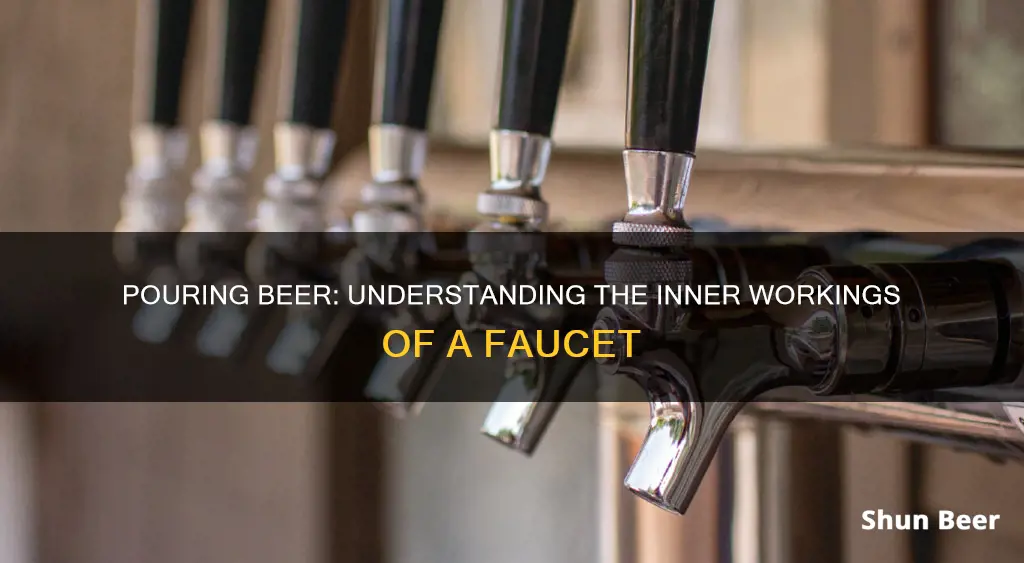
The beer faucet, also known as the beer tap, is the final component that beer interacts with before it reaches your glass. It is an important, yet often overlooked, part of the beer-dispensing process. The faucet is responsible for directing the flow of beer and ensuring a perfect pour. It is also what the tap handle connects to, which is used to commence and suspend the flow of beer. In this article, we will explore the different types of beer faucets and how they work to deliver that perfect pint.
What You'll Learn

The importance of keeping the keg cold
Keeping the keg cold is essential to ensure the beer stays fresh and tasty. Warm kegs can cause the beer to spoil faster, release more bubbles due to carbon dioxide, and even result in a metallic taste. Therefore, maintaining a cold temperature is crucial to preserve the beverage's flavour and integrity.
There are several ways to keep a keg cold. One common method is to use a kegerator, which is a combination of a keg and a refrigerator. It keeps the keg in a freezer-like environment, ensuring the contents remain chilled. However, kegerators tend to be expensive and challenging to transport.
An alternative is to use a keg tub, which is a large container that can snugly hold a keg and keep it surrounded by ice. The process involves placing ice at the bottom of the tub, gently lowering the keg, and then filling the remainder with more ice and ice water. This method is cost-effective and easily transportable due to its rope handles.
Another option is to use a jockey box, a mobile draft beer system built into a generic cooler. The beer flows from the keg into chilled coils inside the cooler, and the other end of the coils connects to a tap. The coils are surrounded by ice, which cools the metal and, in turn, the beer as it travels to the tap. Jockey boxes are easy to transport and can cater to multiple kegs simultaneously.
Additionally, one can use an insulated jacket or sheet, also known as a keg blanket or sleeve, to maintain the keg's temperature. These wraps are designed to fit snugly around the keg, providing insulation and protecting the exterior from bumps and scratches. Some jackets even have pouches for ice packs, ensuring the keg stays cold during transport.
For those seeking a creative solution, one unconventional method is to dig a hole in the ground, line it with garbage bags or a tarp, fill it with ice, and place the keg inside. This improvised tub keeps the keg cold without the need for a separate cooler or freezer.
In summary, keeping the keg cold is of utmost importance to maintain beer quality and taste. By utilising various methods such as kegerators, keg tubs, jockey boxes, and insulated wraps, one can ensure the keg's temperature remains optimal, resulting in a refreshing and delightful beverage.
Colorado EBT and Beer: What's the Deal?
You may want to see also

The role of the coupler
The coupler is an essential component of a beer faucet. It serves as the connection point between the keg and the draft beer system, facilitating the smooth flow of beer from the keg to the faucet. The coupler attaches directly to the keg, forming an airtight seal, and has two ports: one for the air line to allow gas to enter the keg, and the other for the beer line to enable the beer to exit.
Couplers are designed to fit specific keg types and are crucial for maintaining the integrity of the beer within. There are several types of couplers, each designed to work with particular keg types and brands. For instance, the D System Coupler, the most common type used in the United States, is compatible with most American domestic beers and features a larger probe. In contrast, the A System Coupler, commonly used for German beers, has a smaller probe size, making it ideal for European kegs.
The coupler plays a pivotal role in the overall draft beer system. It ensures that the beer is dispensed effectively and maintains the proper pressure and flow of gas into the keg. By controlling the gas flow and pressure, the coupler helps regulate the carbonation level, temperature, and pressure of the beer, ensuring optimal taste and appearance.
Additionally, the coupler's design allows it to act as a critical junction point in the draft beer dispensing process. It connects to the air line, which transports pressurized gas from the tank, and the beer line, through which the beer travels to the faucet. The coupler's airtight seal and specific design for different keg types ensure a secure connection and smooth beer flow.
Krups Beertender: Compatible With Other Beers?
You may want to see also

The journey from keg to faucet
The next step is to apply gas pressure to the keg. This is done through the use of a coupler, which connects to the valve on top of the keg. The coupler has two ports: one for the air line to attach, allowing gas to be pushed into the keg, and one for the beer line, through which the beer flows out. The gas applied is usually carbon dioxide or a mixture of carbon dioxide and nitrogen, known as beer gas. This gas pressure forces the beer out of the keg and through the beer line, which is typically made of vinyl or polyethylene.
The beer then travels up to the draft tower, where all the beer lines are housed, and on to the faucet, also known as the tap. The faucet is the last component the beer touches before it is dispensed into your glass. It is controlled by a tap handle, which is pulled to commence the flow of beer. The faucet helps to direct the flow of the beer and ensure a perfect pour, with the right amount of foam.
The entire process is a delicate balance, as too much or too little pressure can result in foamy or flat beer. The temperature of the beer and the distance it has to travel from keg to faucet also play a role in determining the correct pressure. Maintaining the right pressure and keeping the system clean are essential to ensuring a properly poured pint.
Beer Sleeves: Do They Keep Drinks Cool?
You may want to see also

The different types of beer faucets
There are several types of beer faucets, each with its own unique features and benefits. Here is a detailed overview of some of the most common types:
Standard Faucets
Standard faucets are the most common type and are typically found in both personal and commercial settings. They are designed to dispense a wide variety of beer styles, including American ales and lagers. These faucets usually feature a rear-sealing design and are available in different shapes, sizes, and finishes. They are known for their ease of installation and compatibility with various dispensing systems.
European Faucets
European faucets function similarly to standard faucets but differ stylistically, featuring a longer and skinnier spout. This design reduces the amount of foam in the pour. However, they may have different threads or a shorter shank, which can affect their compatibility with American dispensing systems, particularly kegerators.
Stout (Nitrogen) Faucets
Stout faucets are designed for nitrogen-based draft systems and are commonly used for dispensing nitro beers and stouts, such as Guinness. They have a very small, precise opening for a slow pour, which creates a creamy, smooth beer with a foamy head. This type of faucet is essential for achieving the unique texture and taste associated with nitro brews.
Forward Sealing Faucets
Forward sealing faucets, also known as ventless faucets, control the flow of beer from the front end, reducing the amount of beer exposed to oxygen. This design minimises beer residue inside the faucet, reducing the risk of bacterial growth and tap handle sticking. Forward sealing faucets have fewer internal parts, making them more durable and cost-effective in the long run.
Self-Closing Faucets
Self-closing faucets are a variation of standard faucets, featuring a spring mechanism that allows them to close automatically when released. This design helps conserve beer and prevent accidental spills. They are particularly useful in busy commercial environments, ensuring that the tap is always closed when not in use.
Flow Control Faucets
Flow control faucets feature longer and thinner openings, allowing for a slower, controlled pour with reduced foam. They are ideal for serving sampler glasses, using frosty mugs, or changing kegs with different beer styles. These faucets are often used for carbonated cocktails and kombucha, helping to manage the pour and prevent foaming issues.
The type of beer faucet used depends on various factors, including the style of beer being served, the dispensing system, and personal preferences. Each type of faucet has its advantages and considerations, and choosing the right one can significantly impact the pouring process and the overall quality of the beer.
Buttermilk Beer Batter: Does Druesteaz Mix Work?
You may want to see also

How to pour draft beer
Step 1: Prepare the Glass
Rinse your beer glass to remove any remaining detergents or residues. This helps with head retention.
Step 2: Begin Pouring
Hold your glass at a 45-degree angle and begin pouring. Pour until the glass is around half full.
Step 3: Adjust the Glass Angle
Turn the glass so that you are now holding it at a 90-degree angle (upright) and finish your pour.
Step 4: Stop Pouring
Stop pouring before the beer reaches the top of the glass, leaving about half an inch of space for the head.
Step 5: Allow the Beer to Settle
The carbonation will cause the head to grow a little more as the beer settles in the glass.
Troubleshooting:
If your beer is coming out too foamy, you may need to adjust the pressure on the keg. If the pressure is too high, the beer will be over-carbonated and will pour too much foam. If the pressure is too low, the beer will be flat.
Snail Solution: Beer Trap's Effectiveness and Efficiency
You may want to see also
Frequently asked questions
A beer faucet, also called a beer tap, is the last component that beer touches before it is poured into your glass. It is meant to direct the flow of the brew and ensure a perfect pour.
The beer faucet is connected to the beer line, which carries beer from the coupler (where gas is pushed into the keg) to the faucet. When the tap handle is pulled, this opens the valve in the faucet, allowing beer to be dispensed.
There are three main types of beer faucets: standard, European, and stout (nitrogen) faucets. Standard faucets are the most common and can be found on most kegerators and commercial draft systems. European faucets have a longer, skinnier spout to reduce foam, while stout faucets have a very small, precise opening for a slow pour, ideal for nitro beers and stouts.
A tap handle or faucet handle is the lever that screws into the beer faucet. When you pull the tap handle, it opens the valve in the faucet, allowing beer to be poured. Tap handles are often used to identify the type of beer being served.
It is important to regularly clean and maintain your beer faucet and other components of the draft beer system. This includes cleaning the beer lines, faucets, couplers, and other parts with cleaning solutions or detergents designed for draft systems. This helps prevent bacteria, mold, and yeast buildup, which can affect the taste and quality of the beer.







